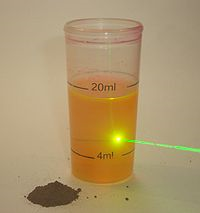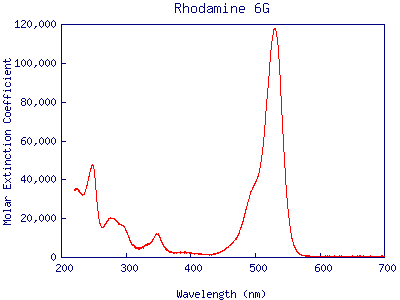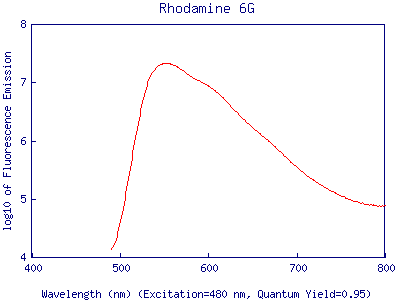Rhodamine G6 Chloride
Use of Rhodamine G6 Chloride
Rhodamine G6 Chloride (RhoG6Cl) is a lipophilic dye that integrates into membranes depending on their charge. Similar to other dyes (such as DioC6) it has therefore been used as mitochondrial tracker and can also record changes of membrane potential in mitochondria. However, at slightly increased concentration, it can also be used to visualise other internal membranes such as nuclear envelope or ER (the plasma membrane with its deviating potential is less attractive for this dye). RhoG6Cl is excited by green light and then yields a red fluorescence. For this reason, it can be used together with GFP or FITC. However, one has to consider that it is also excited by blue light, such that separation of signals has to be achieved by selecting the emission channel accordingly.
Molecular Properties
- absorption at 480-530 nm, emission at >550 nm (broad shoulder in the red)
- molecular weight 479
- stock solution 1 mM in EtOH or water, working solution 10 µM for plant cells (for ER)
- storage light protected, at -20°C longer than a year
- membrane permeable
Applications in Plants
- labelling mitochondria and endomembrane system. sample movie mitochondrial movement along microtubules.
- double labelling with GFP possible, when emission filter is used with a cut-off below 550 nm
Side Effects
- in case of in-vivo staining: the membrane potential of mitochondria is progressively impaired, any observation beyond 5-10 min is likely to cause artifacts.
- Alternatively: mild fixation to prevent changes (but not allowing for in-vivo observation).
- In yeast RhoG6Cl blocks the membrane based ABC transporter (Pdr5p)
References
- use of RhoG6Cl to stain ER – Terasaki et al. 1984
- RhoG6Cl blocks oxidative phosphorylation in mitochondria – Gear 1974
- Comparison different rhodamine dyes to track membrane potential – Johnson et al. 1981
- Use of RhoG6Cl to see endomembrane changes in maize after mild fixation – Waller et al. 2002
- Inhibition of ABC-transporter in yeast - Bartosiewicz et al. 2009




